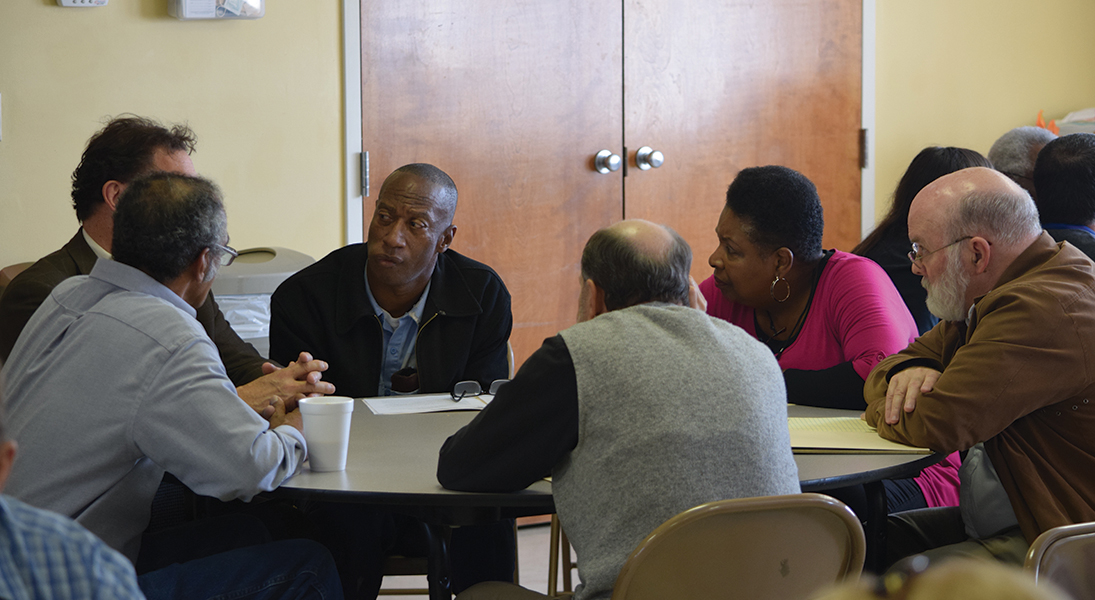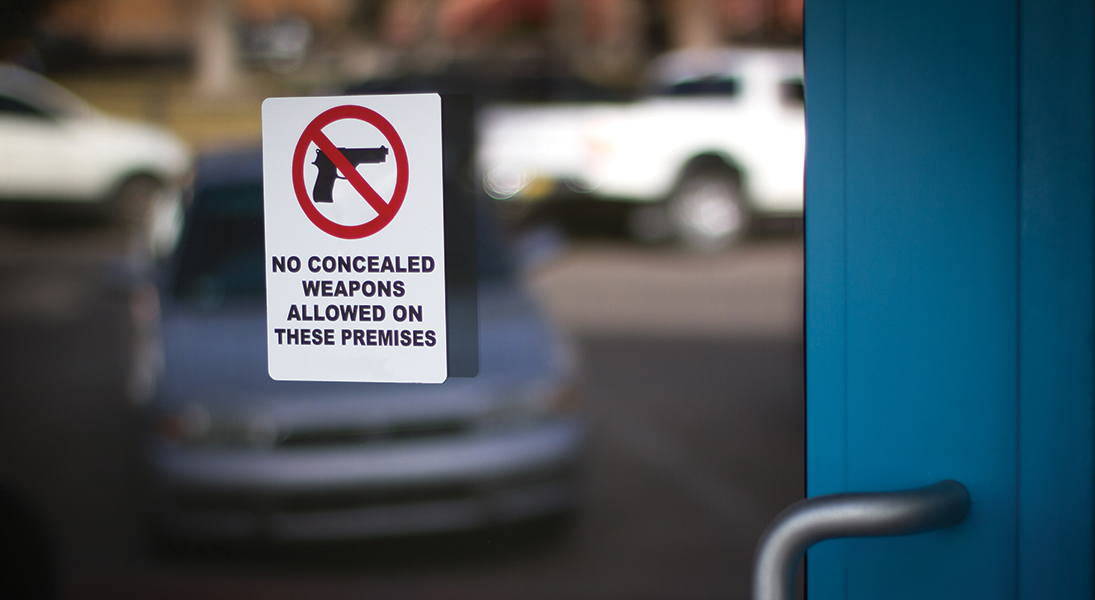Security-trained greeters took note when the disheveled white man in a trench coat arrived for worship at Christ Mission, a mostly African-American congregation in Columbia, S.C. Suspicion turned to alarm when they perceived something bulky under his coat. A weapon?
With the painful memory still fresh of the 2015 hate-crime when a white visitor murdered nine African-Americans at Charleston’s Emanuel African Methodist Episcopal Church, Christ Mission team members followed their playbook, positioning themselves around the visitor while someone greeted him warmly and invited him in.
Once at his seat, the visitor took off his jacket and revealed what he was carrying.
“He had Bibles!” said Leroy Cannon, pastor of Christ Mission. “We started saying, ‘Hallelujah.’ ”
That incident was a false alarm, but Cannon’s congregation was on its toes and prepared for the worst. After the Emanuel murders and last fall’s shooting at First Baptist Church outside San Antonio that left 26 people dead, congregations know they can’t take anything for granted.
“We’ve got to be vigilant in all aspects and we cannot relax,” said Cannon, who lost two friends in the Emanuel shooting.
Cannon helped organize a program in the South Carolina Synod for leaders to talk about the difficult issue of church safety.
“We can’t give simple answers to a complex question, but we can bring people together and host a conversation,” said Herman Yoos, the synod’s bishop.
Program participants shared their experiences, fears and solutions. Then they heard tips from a sheriff’s deputy. They also paused regularly to pray and study Scripture passages that speak of “God’s love and grace upholding us in scary and shaky times,” Yoos said. Included were Jesus’ emphatic message of peace in John 14:27 and Psalm 46’s declaration that “God is our refuge and strength.”
The approach—trust in God but be prepared—balances the faithful with the practical and provides a wise middle ground for congregations that struggle with sometimes-conflicting goals. On the one hand, they have to be friendly and welcoming to visitors. On the other hand, they have to be wary of people who could cause them harm.
“We have an ethical, moral and biblical imperative to care for the flock and care for those who come to worship,” said Glenn Beard, director of the Lower Susquehanna Synod’s Lutheran Disaster Response Task Force.
Beard works with congregations on church safety and encourages them to see security as a ministry that is essential in our culture. Many congregations naively think “it can’t happen here, or God will protect us,” he said. The “Ostrich Approach” is not helpful, but neither is the “Chicken Little Approach.”
“It’s a balance that needs to be drawn between being panicked about security and being oblivious to the idea of security,” Beard said.
A road-raging driver who followed her into the church parking lot helped open the eyes of St. John Evangelical Lutheran Church, Hummelstown, Pa., said Martha Boyd, its pastor. The driver sped off when she entered the church, but it raised a question for the small, country church: how safe were they really?
“It’s a balance that needs to be drawn between being panicked about security and being oblivious to the idea of security.”
The congregation installed cameras and sturdy locks and called on Beard to help them explore ways to live into a 21st-century mindset that embraces both security and hospitality. It’s not always easy.
“While they lament that they have to think about locking their doors or taking precautions or having training, it’s the reality of the day,” Boyd said. “We can’t take for granted that whoever’s walking in our doors has good intentions.”
Church safety preparedness and training is important, but especially for leaders, said Chelle Huth, director of lifelong learning at United Lutheran Seminary in Philadelphia and Gettysburg, Pa.
“When a situation occurs, everybody is going to look to the church leader for direction,” said Huth, who organizes safety training sessions for future and current congregational leaders.
Common sense, awareness, thinking through the issues and taking even simple steps can help keep people safer, Huth said.
Developing plans and scenarios can start with asking: What are our vulnerabilities? When and where do we need to have people watching for trouble? Are they trained in what to look for and what to do? What do we do when someone suspicious comes to church?
For congregations that want to be safer, calling the police or sheriff’s department is a good first step. Officers can point out security weaknesses, provide training, and help develop protocols and procedures. And, as the sheriff’s deputy who spoke at the South Carolina Synod event said, safety measures need not be expensive or complicated.
“One of the best suggestions was simply having greeters at the front door,” Yoos said. Trained greeters could welcome strangers and sit with them at worship. It would not only keep the church safer but also extend hospitality.
“It would be amazing if we actually became more friendly because we’re concerned about safety,” Yoos said.
Tips and resources to keep your church and God’s people safe
Our Lord sent out his disciples with keen advice that may apply to us as we grapple with security in the 21st century: “I am sending you out like sheep into the midst of wolves; so be wise as serpents and innocent as doves” (Matthew 10:16).
Knowing that a dangerous situation can occur at any time and in any place—even in a house of God—we need to be as wise as serpents and prepare for the worst, even as we pray that our houses of worship will be safe.
“There’s still a strong percentage of folks who think that security is not something they need to worry about at a church setting,” said Glenn Beard, coordinator of the Lutheran Disaster Response Network for the Lower Susquehanna Synod. “And obviously, we know that’s not the case.”
From interviews with Beard and other Lutherans involved in security, here are some basic tips that can get you started, followed by resources for further exploration and planning.
Work with law enforcement. Your local police and sheriff’s department are your partners in keeping people safe. Officers are the people who respond in the event of an emergency, so it’s helpful for them to have a relationship with your congregation and familiarity with your building and leaders.
- Invite officers to tour your church with your leadership team. Officers can point out security weaknesses and suggest commonsense measures.
- Ask officers to assist you in devising a plan in the event of a shooting in your church.
- Ask officers to work with leaders of the congregation to train members on what to do in the event of an emergency.
Form a plan. Congregations are safer when there are plans in place in the event of emergencies and people know what to do. Law enforcement officers and risk-assessment personnel from your congregation’s insurance company can help you think through the “what ifs” and make plans. Teach the plans to your members and especially church leaders, who will help carry them through in an emergency.
Form a team. From your congregation or community, who can help with church security plans? Who are the leaders? Retired or active police officers and military personnel are a good bet, as are firefighters, emergency medical technicians and civilians who work on security for their workplace. Other leaders include teachers, doctors, nurses and anyone else who can think clearly and act calmly under stress.
Have secure locks. Check doors and windows to make sure the locks are working and secure. Replace or upgrade as necessary.
Have a lock-check protocol. Locks won’t protect you if they aren’t engaged. Put in place a schedule and procedure to double check that the windows and doors are locked, especially when church activities are done for the day.
Limit access. Be aware of what church doors are open and when, and be aware of who comes and goes from church, especially on busy Sundays.
Appoint and train greeters. Have people at the doors on Sunday who can say hello to everyone. In addition to being friendly and inviting, they can also be trained to spot suspicious visitors.
Monitor the parking lot. On Sundays, have someone watch the parking lot for suspicious activity. The presence of someone in the parking lot wearing an orange-and-yellow reflective vest will not only deter troublemakers but also make people feel safer.
Invest in technology. Security cameras might be a cost-effective way to watch the doors and grounds of your church.
Resources
“Active Shooter Resources” – The Federal Bureau of Investigation offers a trove of resources to help develop a response plan.
“Active Shooter Preparedness” – The U.S. Department of Homeland Security offers online training and resources for groups and individuals.
“Run, Hide, Fight” – This video from the Federal Emergency Management Agency (FEMA) looks at a basic, three-step approach for when a shooter comes to your building.
“Resources to Protect Your House of Worship” – FEMA has dozens of tip-sheets, how-to articles, in-depth reports, webinars and more to help keep your congregation safe.
“Active Shooter Training for Churches” – The Foursquare Church has assembled these resources, including a 37-minute training video for congregations.
“Protect Your Congregation from a Gunman” – Writing in Christianity Today, Police Chief Andrew Mills from Santa Cruz, Calif., gives some important steps.









